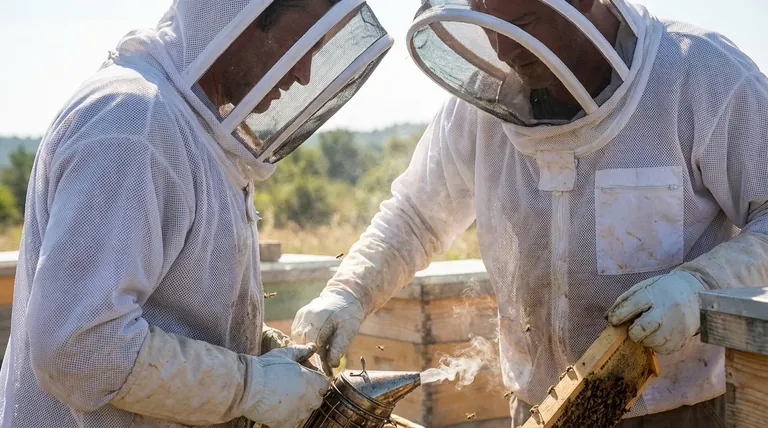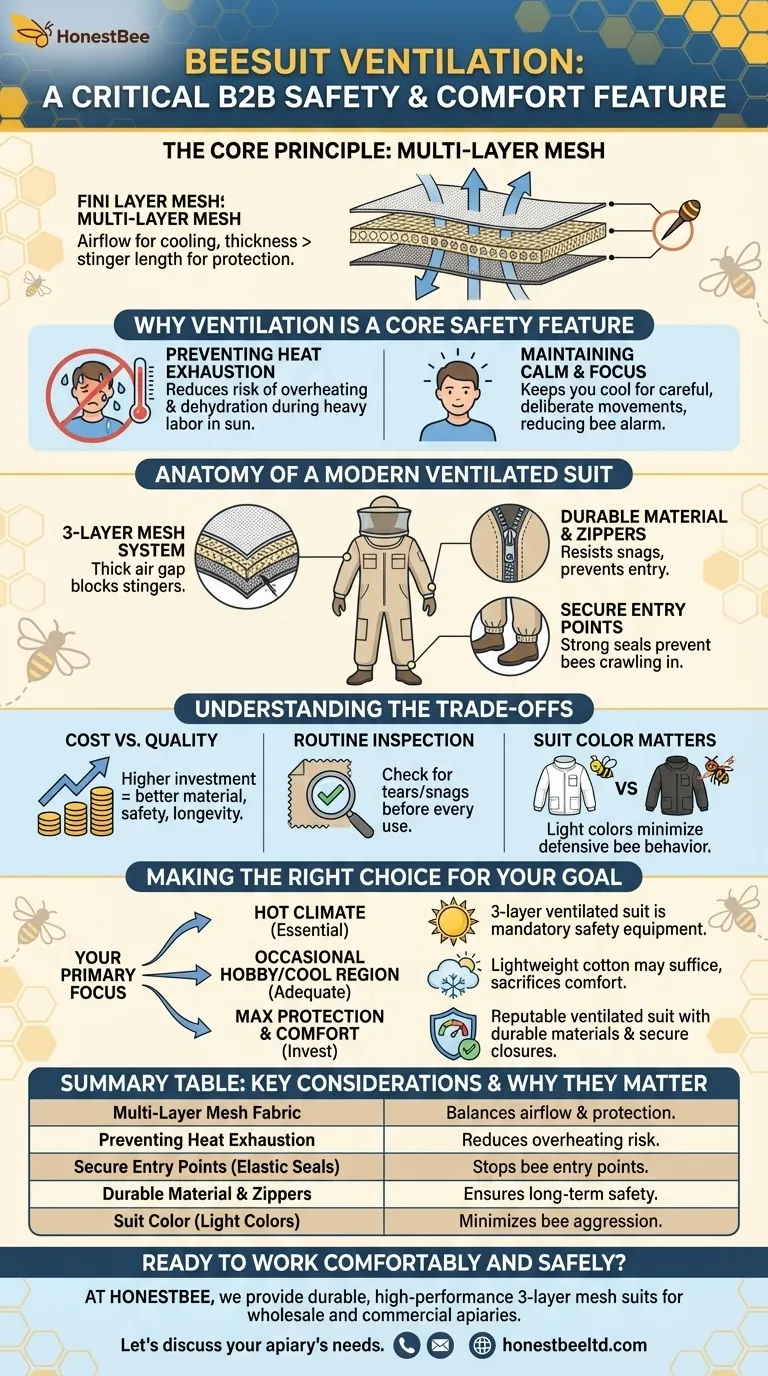When considering ventilation in a beekeeping suit, the primary factor is the use of a multi-layer mesh fabric. This design allows for maximum airflow to keep you cool and prevent overheating, while the thickness of the combined layers is engineered to be greater than the length of a bee's stinger, providing robust protection. This makes ventilation a critical feature for both safety and comfort, especially in warm climates.
Choosing a beekeeping suit is not just about avoiding stings; it's about creating a safe and comfortable working environment. The right ventilation system directly impacts your stamina, focus, and ability to work calmly with your hives during the hottest parts of the day.

Why Ventilation Is a Core Safety Feature
Many new beekeepers view ventilation as a luxury for comfort. In reality, it is a critical component of personal safety, particularly during long hive inspections on sunny days.
Preventing Heat Exhaustion
Beekeeping is physical labor. Lifting heavy boxes and moving equipment in direct sun quickly raises your body temperature. A ventilated suit allows heat and moisture to escape, significantly reducing the risk of dangerous heat exhaustion and dehydration.
Maintaining Calm and Focus
When you overheat, your heart rate increases, you become irritable, and your movements can become clumsy. A well-ventilated suit helps you stay cool and calm, which is essential for making careful, deliberate movements that don't alarm the bees.
The Anatomy of a Modern Ventilated Suit
Understanding how these suits are constructed helps you identify quality and make an informed decision. The best designs balance airflow, protection, and durability.
The 3-Layer Mesh System
The most effective ventilated suits use a 3-layer mesh construction. This design sandwiches a thick, open-weave material between two finer layers of mesh. This creates a significant gap of air between your body and the outer surface, making it nearly impossible for a stinger to reach your skin.
Material Quality and Durability
The effectiveness of the mesh depends on its quality. Look for durable materials that resist tearing. High-quality zippers and strong stitching are equally important, as these are common failure points that can allow bees inside.
Secure Entry Points
Excellent ventilation is useless if bees can easily crawl inside the suit. Ensure any potential suit has strong elastic seals at the wrists and ankles. A secure connection between the suit's collar and the hooded veil is also non-negotiable.
Understanding the Trade-offs
While ventilated suits offer superior performance in warm weather, there are practical considerations to keep in mind.
Cost vs. Quality
High-quality, multi-layer ventilated suits are a significant investment compared to simple cotton suits. Be wary of suits priced exceptionally low, as they often cut corners on material quality, zipper strength, and overall construction, compromising your safety.
Routine Inspection is Crucial
The mesh fabric that provides ventilation can be susceptible to snags and tears from branches or sharp corners on equipment. Before every use, you must carefully inspect your suit for any holes and repair them immediately.
Suit Color Matters
Bees have evolved to perceive dark, furry animals (like bears) as threats. For this reason, nearly all quality bee suits, ventilated or not, come in white or other light pastel colors. A dark-colored suit will attract more defensive behavior from the bees, regardless of its ventilation.
Making the Right Choice for Your Goal
Your local climate and beekeeping intensity should guide your decision.
- If your primary focus is working in a hot climate: A 3-layer ventilated suit is an essential piece of safety equipment, not a luxury.
- If your primary focus is occasional hobby beekeeping in a cool region: A less expensive, lightweight cotton suit might be adequate, but you will sacrifice significant comfort on warmer days.
- If your primary focus is maximum protection and comfort: Invest in a reputable brand's ventilated suit known for its durable materials, robust zippers, and secure elastic closures.
Choosing the right suit empowers you to be a better, more attentive beekeeper by removing the distraction of discomfort and heat.
Summary Table:
| Key Consideration | Why It Matters |
|---|---|
| Multi-Layer Mesh Fabric | Allows airflow while blocking stingers, balancing comfort and protection. |
| Preventing Heat Exhaustion | Reduces risk of overheating during physical labor in the sun. |
| Secure Entry Points (Elastic Seals) | Prevents bees from entering the suit through cuffs and collar. |
| Durable Material & Zippers | Ensures long-term protection and prevents suit failure. |
| Suit Color (Light Colors) | Minimizes defensive bee behavior; dark colors attract more attention. |
Ready to work comfortably and safely with your bees?
At HONESTBEE, we understand that a well-ventilated suit is essential for commercial apiaries and distributors who demand both superior protection and all-day comfort for their teams. Our wholesale-focused operations provide durable, high-performance beekeeping suits built with the 3-layer mesh system discussed here, ensuring your beekeepers stay cool, calm, and protected.
Let's discuss your apiary's needs. Contact our team today to learn more about our wholesale supplies and equipment.
Visual Guide

Related Products
- Cotton Beekeeping Suit and Round Hat with Veil Bee Keeper Protective Gear
- White Beekeeping Protective Suit and Hat with Fencing Veil for Beekeepers
- Beekeeper Cowboy Hat and Veil for Beekeeping
- Heavy Duty Cowboy Beekeeper Hat with Visibility Veil Outdoor Professional Beekeeping Protective Gear
- Professional Beekeeping Suit for Kids and Girls Childrens Bee Keeper Suit
People Also Ask
- What factors should be considered when choosing a beekeeping suit? Balance Safety, Comfort & Performance
- What is recommended for beginners in beekeeping regarding protective clothing? A Complete Safety Guide for New Beekeepers
- Why is a jacket with a hat veil recommended for beekeepers? Essential Protection for Your Face and Neck
- What are bee suits made of? Choosing the Right Material for Maximum Protection & Comfort
- How should a bee suit be cleaned? Protect Your Investment and Ensure Apiary Safety



















